Plum pudding model - Study guides, Class notes & Summaries
Looking for the best study guides, study notes and summaries about Plum pudding model? On this page you'll find 252 study documents about Plum pudding model.
Page 2 out of 252 results
Sort by
![2023 AQA GCSE CHEMISTRY 8462/1H Paper 1 Higher Tier Question Paper & Mark scheme (Merged) June 2023 [VERIFIED]](/docpics/5285349/66420845bbb9f_5285349_121_171.jpeg)
-
2023 AQA GCSE CHEMISTRY 8462/1H Paper 1 Higher Tier Question Paper & Mark scheme (Merged) June 2023 [VERIFIED]
- Exam (elaborations) • 68 pages • 2024
- Available in package deal
-
- $7.99
- + learn more
GCSE CHEMISTRY Higher Tier Paper 1 Monday 22 May 2023 MorningTime allowed: 1 hour 45 minutes Materials For this paper you must have: • a ruler • a scientific calculator • the periodic table (enclosed). Instructions • Use black ink or black ball-point pen. • Pencil should only be used for drawing. • Fill in the boxes at the top of this page. • Answer all questions in the spaces provided. Do not write outside the box around each page or on blank pages. • If you need...

-
AQA AS Physical Chemistry Exam Questions and Answers
- Exam (elaborations) • 45 pages • 2024
-
- $13.49
- + learn more
AQA AS Physical Chemistry Exam Questions and Answers Who described atoms as solid spheres that make up different elements and when? - Answer- John Dalton in the 19th century Who suggested that atoms of a particular element had the same mass and atoms of different elements had different masses and when? - Answer- John Dalton in 1803 Who discovered the electron and when? - Answer- JJ Thomson, 1897 discovered electrons proving atoms weren't indivisible or solid. New model named plum puddin...

-
June 2024 QP - Paper 1 AQA Chemistry AS-level
- Exam (elaborations) • 57 pages • 2024
-
- $5.79
- + learn more
Section A Answer all questions in this section. 0 1 This question is about atomic structure. In the nineteenth century JJ Thomson discovered the electron. He suggested that negative electrons were found throughout an atom like ‘plums in a pudding of positive charge’. Figure 1 shows an atom of element R using the ‘plum pudding’ model. An atom of R contains seven electrons. Figure 1 0 1 . 1 State two differences between the ‘pl...
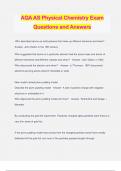
-
AQA AS Physical Chemistry Exam Questions and Answers
- Exam (elaborations) • 45 pages • 2024
-
- $13.49
- + learn more
AQA AS Physical Chemistry Exam Questions and Answers Who described atoms as solid spheres that make up different elements and when? - Answer- John Dalton in the 19th century Who suggested that atoms of a particular element had the same mass and atoms of different elements had different masses and when? - Answer- John Dalton in 1803 Who discovered the electron and when? - Answer- JJ Thomson, 1897 discovered electrons proving atoms weren't indivisible or solid. New model named plum puddin...
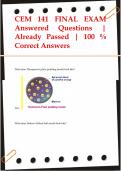
-
CEM 141 FINAL EXAM Answered Questions | Already Passed | 100 % Correct Answers
- Exam (elaborations) • 19 pages • 2024
- Available in package deal
-
- $12.49
- + learn more
What does Thompson's plum pudding model look like? Ans: What does Dalton's billard ball model look like? Ans: What does Rutherford's planetary model look like? Ans: Out of Dalton's, Rutherford's and Thompson's model, which model would support the claim that "atoms are composed of mostly empty space"? Ans: Rutherford's planetary model "Does the planet Venus have phases (for example full or quarter) like the moon?" Is this question a scientific question? Ans: Yes, becaus...
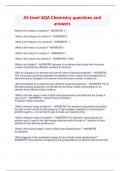
-
AQA AS Physical Chemistry 2024 exam questions with 100% correct answers
- Exam (elaborations) • 16 pages • 2024
-
- $14.49
- + learn more
AQA AS Physical Chemistry 2024 exam questions with 100% correct answers Who described atoms as solid spheres that make up different elements and when? - ANSWERS John Dalton in the 19th century Who suggested that atoms of a particular element had the same mass and atoms of different elements had different masses and when? - ANSWERS John Dalton in 1803 Who discovered the electron and when? - ANSWERS JJ Thomson, 1897 discovered electrons proving atoms weren't indivisible or solid. New m...
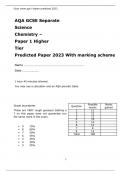
-
AQA GCSE Separate Science Chemistry – Paper 1 Higher Tier Predicted Paper 2023 With marking scheme
- Exam (elaborations) • 28 pages • 2023
-
- $24.29
- 1x sold
- + learn more
AQA GCSE Separate Science Chemistry – Paper 1 Higher Tier Predicted Paper 2023 With marking scheme Name …………………………………………………………………… Date ………………… 1 hour 45 minutes allowed. You may use a calculator and an AQA periodic table. Grade boundaries These are VERY rough guesses! Getting a 7 on this paper does not guarantee you the same mark in the exam. • 9 70% • 8 60% • 7 50% • 6 45% • 5 35% ...
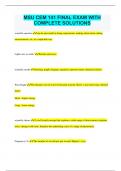
-
MSU CEM 141 FINAL EXAM WITH COMPLETE SOLUTIONS
- Exam (elaborations) • 42 pages • 2024
- Available in package deal
-
- $11.49
- + learn more
MSU CEM 141 FINAL EXAM WITH COMPLETE SOLUTIONS scientific question can be answered by doing experiments, making observation, taking measurements, etc. in a replicable way Lights acts as what? Particle and wave. scientific model drawing, graph, diagram, equation. represent many chemical entities. Wavelength The distance (m) of waves from peak to peak. Short: x-ray (red), long: infrared (blue) Short - higher energy Long - lower energy scientific theory A well tested concept t...
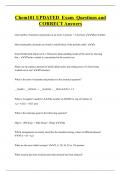
-
Chem101 UPDATED Exam Questions and CORRECT Answers
- Exam (elaborations) • 28 pages • 2024
-
- $8.49
- + learn more
total number of neutrons and protons in an atom; # protons + # electrons Mass Number Most nonmetallic elements are found in which block of the periodic table? p Ernest Rutherford disproved J.J. Thomson's plum-pudding model of the atom by showing that... Positive matter is concentrated in the central core Plants use up copious amounts of which alkali metal, preventing most of it from being washed out to sea? Potassium What is the ratio of reactants and products in the chemical equation? ...
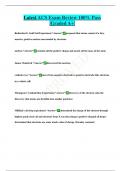
-
Latest ACS Exam Review 100% Pass |Graded A+|
- Exam (elaborations) • 21 pages • 2024
- Available in package deal
-
- $9.49
- + learn more
Latest ACS Exam Review 100% Pass |Graded A+| Rutherford's Gold Foil Experiment *Answer* proposed that atoms consist of a tiny, massive, positive nucleus surrounded by electrons nucleus *Answer* contains all the positive charge and nearly all the mass of the atom James Chadwick *Answer* discovered the neutron cathode rays *Answer* move from negative electrode to positive electrode (like electrons in a voltaic cell) Thompson's Cathode Ray Experiment *Answer* discovery of the electron ...

That summary you just bought made someone very happy. Also get paid weekly? Sell your study resources on Stuvia! Discover all about earning on Stuvia


